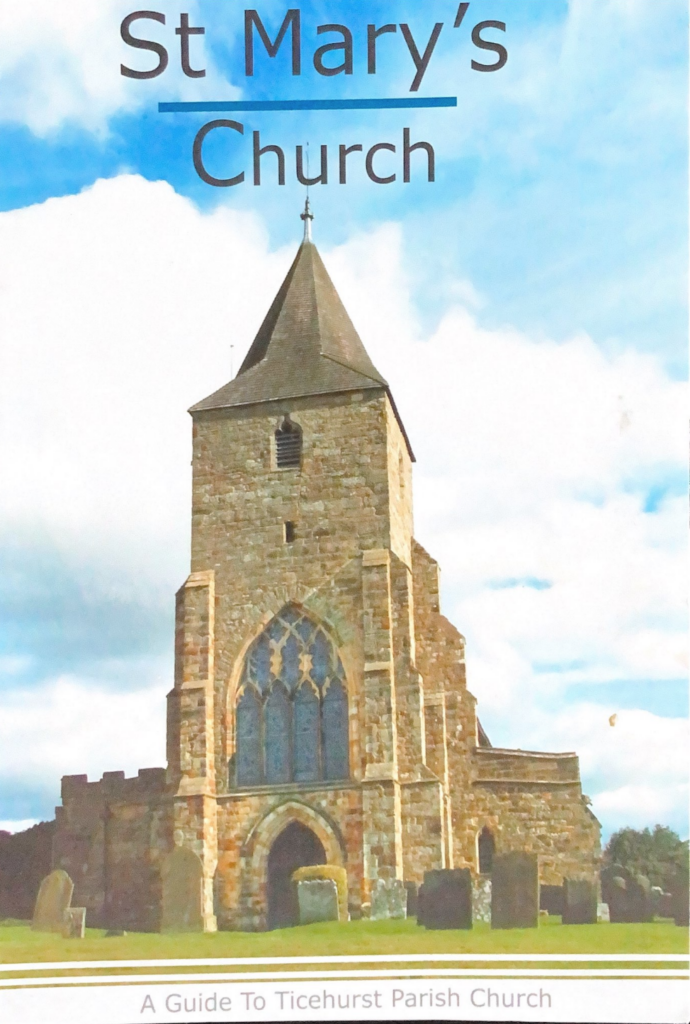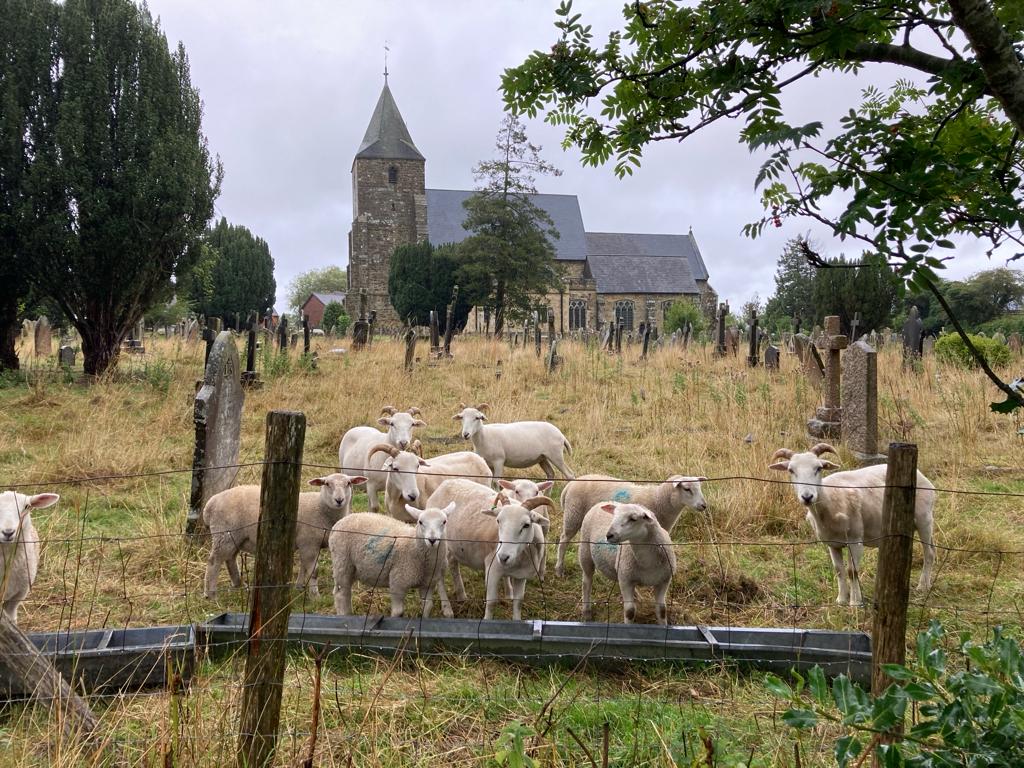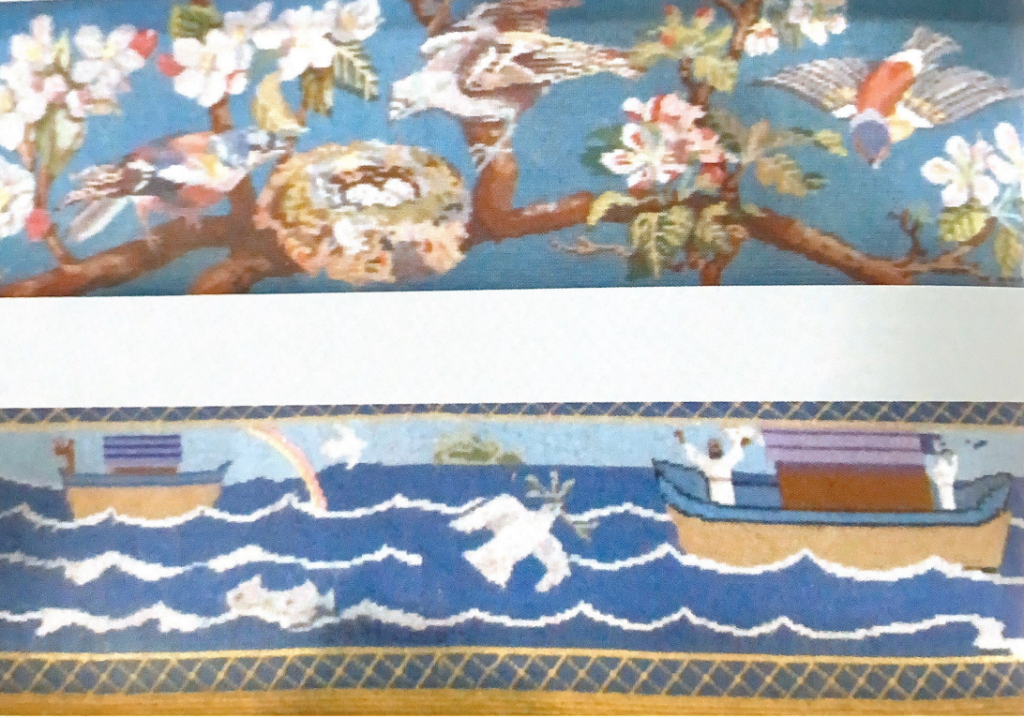Visitor Information
Historical Background
In the year 1018 King Cnut made a grant to Aelfstan, Archbishop of Canterbury of “a certain little woodland pasture in the famous wood of Andredeswealde which is commonly called Haeselersc…” The name survives today as Hazelhurst Farm in Ticehurst parish.
The Domesday Survey which started in 1086 does not mention Ticehurst, but it refers to “Hasslesse” (again Hazelhurst).
The earliest reference to Ticehurst is in a document of 1180 relating to Combwell Priory and mentions “Adam, Presbyter de Tychenherste. In 1197 the church at Ticehurst is confirmed as coming under Hastings Priory.
No records of the building of the present church have been traced, but from the style of the architecture it is calculated that much of it dates from the 14th century. The arms of the Etchingham family appear in the stonework of the porch ceiling and in a stained glass window. As the Etchinghams were responsible for the rebuilding of Etchingham church (completed in 1363) it is thought likely that they were responsible for similar work at Ticehurst.

Early records of the history of the church are few. However the Parish Registers from 1559 to the present day (apart from the Cromwell era – 1641-53) are now in the care of the County Records Office at Lewes. The names of the vicars are known from early in the 15th Century and are listed in the church.
During the 18th century seems to have been well looked after, but in the first half of the 19th century there was serious neglect until the arrival in 1851 of the Revd Arthur Eden, who found it in a very dilapidated state. In 1856 he supervised the rebuilding of much of the chancel and the north chapel at a cost of £1, 309, which he raised by public subscription. Internal work at that time included removal of four early 19th century galleries, one in each side aisle and two, one above the other, in front of the tower.
Much of the stained glass in the church was put in during the second half of the 19th century. Mr Eden’s second major restoration was in 1901, when further significant changes were made.
The 20th century saw a series of maintenance, repair and restoration works, as is necessary for a Grade II* listed building (ie one of ‘National Importance’). In 1949 the removal of the bells for tuning and re-hanging on new bearings. In 1972 some £9,000 was spent on exterior stonework and treatment of timbers. The great storm of 1987 resulted in over £15,000 worth of work on some roofs. In 1990 substantial work costing about £20,000 was carried out to provide a new ringing chamber, structural repairs to the stonework and reordering of vestries and chapels. A further £30,000 was spent on roofs in 2001.
The Churchyard
St Mary’s Churchyard probably dates back to before the Norman Conquest and the ground surrounding the church must have been buried-over many times in the following millennium. As full a list as possible of memorials and identified graves is kept in the Visitors Corner of the church. The earliest has been dated 1490 but registers of burials only started in 1560.
Much of the churchyard is now closed to new burials. The garden of remembrance for the interment of ashes was consecrated in 1962, while the Book of Remembrance (in the Courthope Chapel) was started in 1969.

Tour of the Church
Outside
The Tower is the oldest and least altered part of the building, most of it being of 13th century origin, although the west window and the arch of the west door are in the “Decorated Style” of the 14th century. The Tower is topped by a short shingled broach spine, with an embattled turret at it’s north-east angle.
The clock in the north face of the tower dates from 1835 although it is thought that there were two earlier clocks one of 1692 having replaced an even earlier one. There are also faint remains of a Mass sundial in one of the stories on the west wall of the south nave which in pre-Reformation times showed the times at which Mass was said. All walls are well supported by buttresses which contribute to the sturdy appearance of the whole building.
Much of the stone tracery of the building’s windows is of either “Decorated” or “Perpendicular” 14th Century styes, although most of them are faithful reproductions made when the chance was largely rebuilt in 1856. At this time too, the north aisle roof was crenelated and had gargoyles added . In 1910 this was also added to the south side.
Porch
Over the entrance of the porch there is a modern carved sone figure of the Virgin Mary, placed there in 1970 as a memorial and filling the niche which had been empty since the Puritan agitation in the 17th century.
The entrance is through a slightly pointed arch in late 14th century style. Inside there is an interesting vaulted roof, meeting in the middle at the Etchingham family shield. On the east wall are boards with the Roll of Honour of those people of the village who served in HM Forces in the two world wars. The memorials of those who died are inside the church.
Inside
On entering the Nave from the north porch one sees to the left, through the arch and carved Rood Screen, the chancel flanked by the North and South Chapels and beyond it the Sanctuary under the big East Window. To the right, through the Tower arch is the bell ringing platform with the big West Window, and below it the screen to the choir vestry.
The roofs of the Nave and the North and South Chapels are supported by crown posts on tie beams which in the nave are 8.5 metres above ground level.
The pews in the church have kneelers mounted on platforms over the central heating pipes. In 1981 Mrs Jean Williams, wife of the newly arrived vicar suggested and then organised the decoration of the kneelers which have continued since then to be designed stitched and fitted by people of the village. The many and varied themes, including local scenes and subjects, are depicted in the needlepoint (canvas work) and are described in detail in the Visitor’s Corner.

The Font
The Font at the south end of the cross aisle has a fine carved oak cover of 16th century origin. There are eight panels, four of which open on hinges, and all are carved with delicate designs of the period. (The top is modern). The remains of the inscription on the plinth read “God “ and “Elizabeth Chefe”. John Sheffe married Elizabeth Swathynge in the church on 17 September 1581.
The Pulpit
The Pulpit was erected in 1856 and replaced one of the old “three decker” type.
War Memorials
These are on the north and south pillars of the chancel arch. To the left is that listing the 62 men of Ticehurst who died in the Great War (1914-1918) and to the right the 20 of the Second World War (1939-1945). As full a list as possible of the details of the men listed on these memorials is available in the Visitors Corner. Further information on these men is always welcomed by the Churchwardens.
The Rood Screen
Above the First World War Memorial is an opening, beyond which is all that remains of the stairs to the Rood Gallery across the entrance of the chancel. This would have supported the Rood (a crucifix) and was probably demolished late in the 16th century. The modern wooden screen and cross was carved at Frant and erected in 1916.
The Lectern and Choir Stalls
The Lectern and Choir Stalls were made by Robert Thompson of Kilburn West Yorkshire, each with his trademark signature of a carved mouse and installed in 1964.
The fine reredos over the altar is by Martin Travers and was installed as part of a restoration of the sanctuary in 1947.
The East Window
In 1856 the stonework of the window was restored and in 1897 the glass in the window was replaced by the present stained glass, the central light having gained first prize at the Paris Exhibition the year before. Some of the original medieval glass was re-used in the window in the north wall of the sanctuary, where the lower left quarter is a remarkable 14th century “Doom” picture showing sinners being taken down to hell, including a bishop a king and a pope! Remaining fragments were used in the window at the west end of the north aisle.
To the south of the chancel is the former Pashley Chapel, now housing the organ and the vicar’s vestry. There are no memorials to the Passeley (Pashley) family or to any other owners of Pashley Manor until the Mays, who owned it from the 16th to 19th century. The present organ made by Norman and Beard was erected in 1909 but included pipework from the previous one by J.W Walker supplied in 1866.
To the north of the chancel is the Courthope Chapel, named for the Courthope family who had a 400 year connection with Whiligh, an estate on the Wadhurst side of the parish. Many members of the family are buried beneath the chapel in the family vault, which is now sealed.
The North Aisle
The north aisle contains a plaque and window in memory of the Revd Arthur Eden, who was the much loved and greatly respected vicar of the parish for over 57 years, and who arranged all the restorations to the church in the second half of the 19th century. The modern “Eden Court” further down Church Street is named after him. During his tenure one of the curates at St Mary’s was the hymn writer The Revd Francis Pott, who is still remembered today for “Angel voices ever singing” and other fine hymns.
The four black and gold panels on the north wall display The Creed, The Ten Commandments and the Lords Prayer and are dated 1764.
Above the north door (the usual entrance to the church) at the top of the modern oak staircase (1992) is a small door giving access to the Porch Chamber of “priests room” which has had a variety of uses, including serving as a prison, a vestry and Sunday School but is now used for storage. The inner door to that chamber is of three massive oak slabs though to date from the 14th century with its original lock and key still in working order.
In the south aisle near the Visitor’s Information Corner there is as full a list as possible of the vicars of Ticehurst from “Adam, Presbyter of Tychenherste of 1160 to the present day.
The Tower
The west walls either side of the tower and the base of the tower are probably among the few remaining parts of the 13th century building. Beneath the great arch separating the lower floors of the Tower from the nave is a panelled wooden screen with ornamental glass (circa 1893) forming the front wall of the choir vestry. Above it is a modern oak glazed panel enclosing the ringing platform, beyond which is the big West Window, which required major repair in 1985. The badly faded face of the upper right-hand figure (St Mark) was then renewed using that of the Rev Arthur Eden whose photograph hangs near the entrance of the choir vestry.
Above the ringing platform hang six bells made in 1771 by Thomas Jannaway of Chelsea, although there were bells in the tower as early as 1542. They were last tuned and re-hung in 1950 and had major restoration work carried out in 2002/3. They are rung every Sunday.
For over seven centuries this church has been at the centre of the village, bearing witness to the living Christian faith.
This brief history shows how successive generations of villagers have contributed to the ongoing process of maintenance, beautification, development and improvement of the church – a process which continues to thus day.
All donations for the upkeep of St Mary’s Church are gratefully received and can be made electronically in the church or remotely by contacting the church wardens
Acknowledgement
The Churchwardens and PCC of St Mary’s Church acknowledge the debt owed to the late Mr Frances Drewe of Oakover for collating this information, which has been compiled using the previous church booklet on the History of St Mary’s and the book “Ticehurst, Stonegate and Flimwell” both of which he wrote.
Other publications available featuring St Mary’s include the 1925 publication “Ticehurst: The Story of a Sussex Parish” by Hodeon and Odell and the Sussex volume of The Buildings of England series originated by Sir Nikolaus Pevsner.
